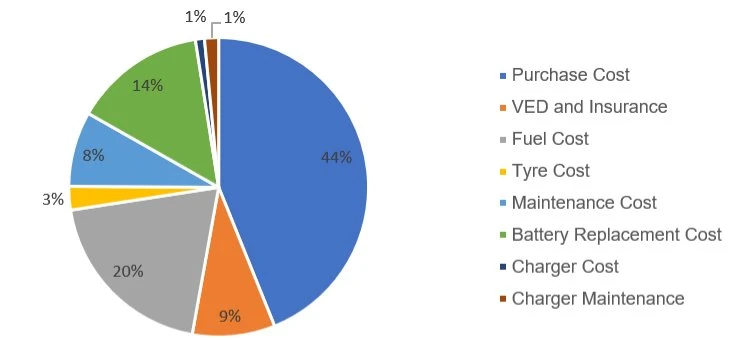[thumbnail]
Summary
The UK government recently brought forward its target for an end to sales of petrol and diesel vehicles to 2035. At the same time Clean air and Zero emission zones are being designed by local city councils across the UK. These factors in combination with an improving electric vehicle (EV) model choice has led to a large rise in the number of fleet operators planning large scale deployments of EVs.
FPS helps operators to look at EV deployment feasibility from a journey and power capacity perspective, but what about costs?
EVs are more expensive to buy and so need to pay back against diesel powered vehicles over a period of several years. Finding pathways to accelerate pay-back is critical for cost effective deployments.
For example, a 3.5T electric van model (such as a Mercedes eSprinter) has to drive at least 27k miles per annum to achieve cost parity with a diesel model. This is beyond the mileages completed by most last mile delivery vehicles and so business as usual deployments rarely offer substantial cost savings.
Our large-scale data analysis for fleet operators identified three pathways beyond typical fleet management approaches that could achieve accelerated payback:
- Targeting regulatory opportunities for preferential city area access;
- Reducing battery replacement costs via contractual means; and
- Minimising electricity costs through smart charging and tariff negotiation.
Our analysis found that breakeven mileages could be reduced to as low as ~4.5 to 5k per annum if optimum configurations are selected and combined using our analytics processes. This mileage is easily within many last mile delivery vehicle duty cycles, which substantially increases the number of EVs that can be cost effectively deployed within fleets.
This blog post discusses ways to reduce EV deployment costs and how FPS can help. If you would like more information about how FPS can enhance the economics of EV deployments in your fleet or help you make better plans, please get in touch with us at info@flexpowerltd.com.
EV Economics
The purchase cost of EVs are ~£10k higher than diesel counterparts even after including subsidies like the plug-in van grant. Some purchase price comparisons are shown in the table below.

Typically, EVs pay back this increased investment through reduced fuel and maintenance costs. In order to accelerate this payback, all operating costs needs to be minimised.
Typical shares of annual operating costs for a Mercedes eSprinter are shown in the pie chart below:

Not shown in the chart is the impact of factors like congestion charging, a fee of £10.50 a day to access certain parts of London. The contribution of this cost can be significant for vehicles frequently visiting these areas.
We have investigated several factors likely to be within operators’ control that could impact operating costs and found the following to be most important:
- Targeting regulatory opportunities for preferential city area access;
- Reducing battery replacement costs via contractual means; and
- Minimising electricity costs through smart charging and tariff negotiation.
City Access Considerations
In some regions EVs will gain preferential access to city centres whereas in others access charges can be avoided. As an indication of the potential savings we looked at London where EVs will continue to be exempt from congestion charging until 2025.
The congestion charge is £10.50 per day levied Monday to Friday and is in place on weekdays except between 25thDecember and 1st January, which means it could be levied 255 times per year or contribute nearly £2,700 to vehicle costs.
Avoiding congestion charge entirely makes eSprinters more cost-effective than diesel counterparts.
The variability of grocery home delivery operations means that vehicle movements are rarely as consistent as this. Our analysis for operators identified entries of vehicles into the zone to range from <1% to >85% of days of the year.
The implication is that where EV economics are being driven by congestion charging or city access, it is worth checking:
- The true frequency with which the target vehicles enter the congestion charging zone.
- That your routing software can preferentially allocate EVs to the congestion charging zone to benefit from this.
Battery Replacement Costs
The impact of battery replacement costs can be significant for EVs and the impact on residual values is still being determined. Combining pack replacement cost figures with OEM warranties estimates of per mile effective battery replacement costs can be developed. The results of this analysis showed a substantial proportion of annual operating costs (~31% in the case of a high range Sprinter) being accounted for by this cost factor.
Because the number of EVs in operation is relatively small compared to the wider vehicle fleet, there are currently in-sufficient EV batteries to satisfy the emerging second life battery market. Within the bus industry where batteries are larger, products are emerging whereby third parties finance vehicle batteries effectively assuming battery degradation risks and replacement costs in exchange for access to end of life batteries.
Similar solutions are emerging for the wider commercial vehicle sector and the impact on payback can be significant. Removing 80% of battery replacement costs has the impact of reducing break even mileage to 13k p.a. vs 27k p.a. in the base case.
FPS can help operators to identify where in their fleet this approach can be applied and assist with designing these sorts of arrangement.
Electricity Prices
Electricity prices are another important factor affecting EV operating costs, contributing about 20% of the total cost of ownership. Unlike diesel prices, electricity prices vary substantially by region and time of day and year. This creates an opportunity to optimise this part of ownership costs.
Our experience of tariffs paid by operators is that electricity prices average around 14p/kWh. The increasing penetration of renewable energy resources like wind in the UK market are increasing the frequency of very low (and even negative pricing periods).
Predictable off-peak loads like EV charging have the potential to access very low electricity prices. Reducing electricity charging prices can substantially improve break even mileages. In our analysis for one retailer, accessing super off-peak pricing consistent with flexible tariffs overnight reduced the breakeven mileage to ~14k pa.
We also found that purchasing higher powered chargers to access lower priced electricity was generally worth doing at most sites provided sufficient supply capacity exists.
FPS’ software tools and services help operators to identify sites where this approach is likely to be successful and calculate cost savings for a variety of tariff scenarios and journey profiles to help operators decide the extent to which this strategy can help them.
Combined Approaches
Decisions made in relation to EV deployments tend to be far more interconnected than those relating to diesel powered vehicles. As a result, operators should consider combining these measures.
In cases we have looked at, picking optimum combinations of all these solutions would make bigger EVs like eSprinters cost-effective at ~4.5- 5k miles pa, which would significantly expand the number of EVs that can profitably be deployed in many fleets.
In one fleet we examined, this approach increased the number of cost effective EVs that could be deployed from about 30 to more than 200 using today’s technologies.
If you would like to learn more about EV economics or talk about how we might de-risk and enhance your EV deployments, please get in touch at info@flexpowerltd.com.
